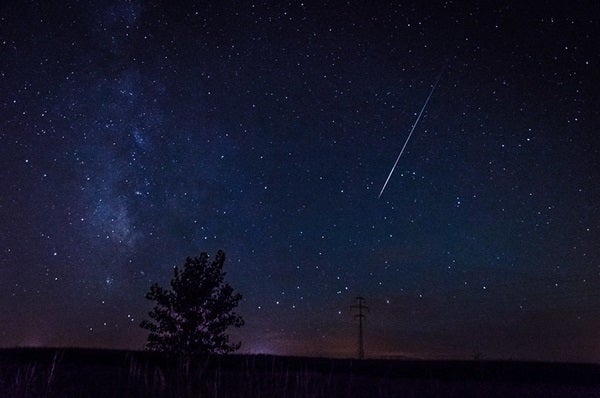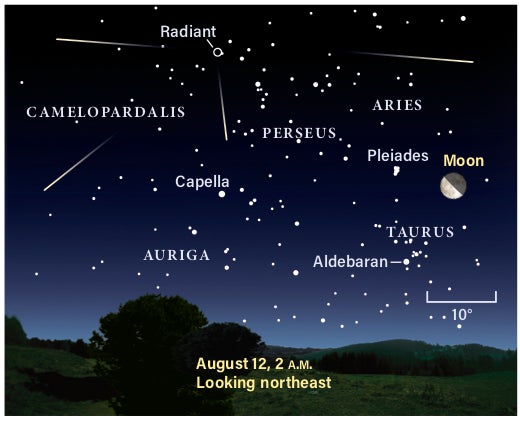When to see the Perseids
The peak of the Perseid meteor shower occurs overnight from August 11 to 12. On August 12, the shower’s radiant — the point on the sky from which shower meteors appear to originate — will be high in the northeast around 2 A.M. local time. That will be the best time to watch for shower meteors, although you’ll likely catch meteors anytime between dusk on the 11th and dawn on the 12th.
Sunset (August 11): 8:01 P.M.
Sunrise (August 12): 6:09 A.M.
Moonrise (August 12): 12:15 A.M.
Moonset (August 12): 2:44 P.M.
Moon Phase (overnight): Waning crescent (45%)
*Times for sunrise, sunset, moonrise, and moonset are given in local time from 40° N 90° W.
If you miss out on the peak, don’t worry — this shower typically builds up and winds down slowly, so you can head out on any of the few days before and after the 12th as well. The peak is just when the best show with the most meteors is expected. In the few days following the peak, the Moon will continue to wane, offering a darker sky in which more meteors might be visible. Shower meteors should be visible until roughly August 26, although rates will drop off with each day past the peak that you observe.
How to see the Perseids
To increase your chances of spotting meteors, you’ll want to get away from light pollution if you can. Find a dark, safe site and set up chairs or a blanket for a clear view of the night sky and aim your gaze about one-third to halfway up in the sky. No telescope or binoculars are required (unless you’d like to spend some of your downtime searching out other night sky targets).
Remember to pack supplies like insect repellant, water, snacks, and a flashlight (preferably with a red lens) for added comfort and convenience, especially if you’ll be skygazing for a while. Even if it’s warm, consider bringing an extra layer or two, both to fend off insects and any overnight breezes.
If you have trouble finding the radiant in Perseus, try looking for nearby Cassiopeia instead — she’s a W-shaped constellation just above Perseus in the early morning sky. Find the central peak of her W and follow a line extended from the two stars that form the left side of that peak downward to find the shower’s radiant, which lies about 13° from the bottom star.
Once you’ve found the radiant, pick a spot slightly away from it to concentrate your search, as that’s where the long trains and streaks should appear. A good rule of thumb is to look about 30° away from the radiant. (The entire Moon only covers about half a degree, so 30° is quite a bit!) And make sure to glance around the entire sky every so often — while most meteors appear to originate from near the radiant, they can streak across any part of the visible sky.
This year, there’s a Last Quarter Moon nearby in Taurus that will, unfortunately, brighten the background sky. That will make it more challenging to spot dimmer meteors, so you definitely can’t expect to see 100 meteors per hour. Instead, you should expect to see somewhere in the ballpark of 50 to 75 meteors per hour from the darkest sites, which is still quite high. And while you might miss out on the maximum number of shooting stars, the quality of those you do catch should be great.
Named for the constellation — Perseus the Hero — from which they appear to originate on the sky, the Perseids occur each year when Earth encounters the dust trail left behind by Comet 109P/Swift-Tuttle, which returns to our neighborhood relatively frequently, thanks to its orbit of just 133 years.
Want to stay up to date on what’s in the sky tonight? We’ve got you covered:
Check out our weekly observing column, Sky This Week!











